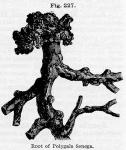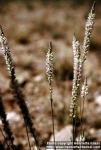Senega (U. S. P.)—Senega.

 Preparations: Fluid Extract of Senega
- Syrup of Senega
- Tincture of Senega
Preparations: Fluid Extract of Senega
- Syrup of Senega
- Tincture of Senega
"The root of Polygala Senega, Linné"—(U. S. P.).
Nat. Ord.—Polygaleae.
COMMON NAMES: Seneka root, Senega snakeroot, Seneca snakeroot.
Botanical Source.—Senega is an indigenous plant, with a perennial, firm, hard, branching root, consisting of a moderately solid wood, and a thick bark; it sends up several annual stems, which are erect, simple, smooth, 8 to 14 inches high, and occasionally tinged with red. The leaves are alternate, nearly or quite sessile, lanceolate, with a sharpish point, smooth, paler underneath, 1 to 3 inches long, and about one-third as wide. The flowers are white, on short pedicels, in a close terminal spike, from 1 to 3 inches in length. Calyx of 5 sepals, the two largest, or wings, concave, roundish-ovate, white, slightly veined, and larger than the petals. Corolla of 3 petals, two lateral and obtuse, and a short-crested extremity; they are small and closed. Capsules small, obcordate, invested by the persistent calyx, compressed, 2-celled, and 2-valved. The seeds are 2 in number, oblong-ovate, acute at one end, slightly hairy, curved, blackish, with a longitudinal, bifid, white strophiola on the concave side. The spike opens slowly, so that the lower flowers are in fruit while the upper ones are in blossom (L.—W.).
History and Description.—Seneka, or Seneca snakeroot, as it is usually called, is found in various parts of the United States, in rocky woods, and on hillsides, flowering in July. Distinction is sometimes made in commerce between Southern and Northern senega. The latter is probably a botanical variety of the former. Southern senega comes from Kentucky, Virginia, Tennessee, North Carolina, Arkansas, Missouri, Ohio, Indiana, and Illinois, while Northern senega, since about 1871, was brought from Minnesota and Wisconsin (J. U. and C. G. Lloyd, Amer. Jour. Pharm., 1881, p. 481; also see Related Species, next page, for False Senega). The dried root, which is the official part, is described by the U. S. P. as "about 10 Cm. (4 inches) long, with a very knotty crown, and spreading, tortuous branches, keeled when dry, fleshy and round after having been soaked in water; externally yellowish-gray or brownish-yellow; bark thick, whitish within, enclosing an irregular, porous, yellowish wood; odor slight, but unpleasant; taste sweetish, afterward acrid"—(U. S. P.). The knotty crown seems to be formed by the junction of several stems; the keel line extends the whole length of the root. The meditullium, or central portion, possesses but little or no medicinal properties, which reside chiefly in the thick, resinous bark. The recent root has a disagreeable, sickening odor, which diminishes very much by drying. Its taste is somewhat sweetish, succeeded by heat and pungency, irritating the mouth and fauces. It imparts its virtues to water or alcohol; alcohol of specific gravity 0.935 is its best solvent. Too high a temperature renders the acrid principle insoluble in water.
Chemical Composition.—The acrid principle of seneca root was discovered, in 1804, by Gehlen, and named senegin by Gmelin. It is the polygalic acid of Quevenne (1836). Bolley (1854) showed senegin to be identical with the glucosid saponin (C32H54O18). W. Procter, Jr. (Proc. Amer. Pharm. Assoc., 1859, p. 297), prepared polygalic acid (senegin) by exhausting the root with diluted alcohol, distilling off the solvent, and precipitating by ether-alcohol. The yield was about 5 per cent. J. Atlass (Ueber Senegin, Dissert., 1887) differentiated polygalic acid, of acid reaction, from neutral senegin, the former being precipitated by both neutral and basic lead acetate, senegin by basic lead acetate only. Senegin (saponin) is a white powder, acrid, excites sneezing, and is readily soluble in water; the solution is neutral, and frothes upon shaking. It is insoluble in absolute cold alcohol, in ether, carbon disulphide, benzin, cold amyl alcohol, etc., very little soluble in chloroform. By boiling with diluted acids, senegin is decomposed into reducing sugar and sapogenin. Atlass obtained from the root 1.64 per cent of senegin. Polygalic acid closely resembles senegin in all its properties, except those mentioned. Joseph Kain (Amer. Jour. Pharm., 1899, p. 86) found in senega another glucosid, laevo-rotatory, and soluble in absolute alcohol and ether. J. H. Schroeder (ibid., 1896, p. 178) made a proximate analysis of the root, and noted the absence of tannin and starch, and the presence of volatile oil, fixed oil, resins, dextrose, saccharose (5.32 per cent), asparagine (0.62 per cent), ash (6.65 per cent). The volatile oil (0.10 per cent on an average) consists chiefly of methyl salicylate and valerianic ester (L. Reuter, Archiv der Pharm., 18,89, p. 313; see ibid., pp. 452, 549, and 927). Roots seemingly exhausted of the oil by distillation with water, produced additional quantities when slightly acidulated; the salicylic ether is also yielded by false senegas of commerce (E. Kremers and Martha M. Tames, Pharm. Review, 1898, p. 45).
Action, Medical Uses, and Dosage.—In large doses, Senega is emetic and cathartic; in ordinary doses, it stimulates most of the secretions, acting especially as a sialagogue, expectorant, diuretic, diaphoretic, and emmenagogue. Its expectorant properties render it very useful in chronic catarrh, and protracted and typhoid pneumonia, bronchorrhoea, chronic bronchitis, with profuse secretion, humoral asthma, and in the commencing stages of croup. In active inflammation its use is contraindicated. In relaxed sore throat, it is recommended as a, local stimulant; also as a diaphoretico-diuretic in rheumatism, and as an emmenagogue in amenorrhoea. It is not without effect upon squamous skin diseases, and its action in this direction should be studied. Dose of the powdered root, from 5 to 20 grains; of the infusion or syrup, from ½ to 2 fluid ounces. The extract prepared from an infusion of the root, obtained by percolation, and evaporated to the proper consistence by means of a water-bath, may be given in doses of from 1 to 4 grains; specific Senega, 1 to 20 drops. Polygalic acid may be given for the same purposes as the root, in doses of from ¼ to ½ grain. It is best taken in hot, sweetened water.
Specific Indications and Uses.—Relaxation of the respiratory mucous membranes and of the skin; cough deep and hoarse, with excessive secretion, mucous rales, nausea, and sometimes vomiting; last stage of typhoid pneumonia, bronchorrhoea.
Other tomes: (Sayre)
Related Species and Substitutes.—Polygala rubella, Willdenow, Bitter polygala, Bitter milkwort. This is the Polygala polygama of Walter. It is an indigenous herb, with a perennial, branched, and somewhat fusiform root. Stems simple, crowded, many from the same root, angular, smooth, and erect, from 6 to 12 feet high. This plant inhabits fields and pastures from Canada to Florida, being common to dry, sandy, or gravelly soils, and bearing handsome rose-purple flowers in July. The whole plant is used. It is inodorous, with a persistent and powerfully bitter taste, which is imparted to water or alcohol. It has not been analyzed, though its active constituent is probably similar to senegin. The Polygala amara, Linné (Herba polygalae), and the Polygala paucifolia, or Fringed polygala, possess similar properties, and may be employed as substitutes. The root of the latter has a pleasant, spicy flavor, very similar to that of gaultheria. In doses of from 3 to 10 grains, bitter polygala is an excellent bitter tonic; from 10 to 30 grains act upon the bowels, and cause slight diaphoresis. An infusion has been found beneficial as a tonic in debility of the digestive organs. It may be used in all cases where a bitter tonic is indicated (Bigelow).
Polygala Nuttallii, Torrey and Gray, Ground centaury.—This plant, called Nuttall's polygala, the Polygala Nuttallii of Torrey and Gray, and the Polygala fastigiata, or P. sanguinea of Nuttall, is an annual plant, with erect, often branched-fastigiate stems, from 6 to 12 inches in height; sometimes 15 or more stems will grow from one root, and on the root will be observed something resembling a nearly developed flower. This plant grows in pine barrens and dry, sandy soils, from Massachusetts to New Jersey, and southward near the coast, flowering from July to October (G.). The whole plant is used. It yields its virtues to water or alcohol. The P. Nuttallii and the P. fastigiata are described by botanists as different species, but they closely resemble each other and possess the same properties. Tonic, alterative, diuretic, and antifuruncular. It has been used as a domestic medicine on Long Island, N. Y., where it has the reputation of being almost infallible as a remedy in fever and ague. Two or 3 drachms of the plant made into a strong decoction will act as a purgative. It is much used, also, as an alterative in boils, cutaneous eruptions, and especially in erysipelas. I have found this plant decidedly efficient in erysipelas and boils, and would recommend it to the profession as a valuable remedial agent, whose powers are not yet fully understood (J. King).
The following species of Polygala have been employed: Polygala scoparia, Kunth, Mexico; P. vulgaris, Linné, Europe; P. major, Jacquin, southeastern Europe (Radix polygalae hungaricae); P. venenosa, Jacquin, Java (reputed toxic); P. Serpentaria, Ecklon and Zeyher, south Africa; and P. butyracea, Africa. The seeds of the latter yield a fat eaten by the native Africans. The P. amara, Linné, of Europe, yields a volatile solid oil, wax, tannin, pectin, and polygalamarin, a very bitter, crystalline principle, which causes water to foam when shaken with it (Reinsch, 1839).
Related to these are Monnina polystachya, Ruiz et Pavon (Peru). Used in metal polishing as a soap, and as a remedy for diarrhoea. The bark of the root yields saponin. Soulamea amara, Lamarck (Molucca Isles), an antiperiodic bitter.
Polygala sanguinea, Linné, Caducous polygala.—New Jersey to Florida. Possesses similar properties to Senega, and may be used as a substitute.
Polygala Boykinii, Nuttall.—Growing in Georgia and southern Tennessee. Its root is smaller than that of Senega, is without keel, and has a uniform bark and cylindrical, woody column. (See its microscopical and chemical examination, by G. Goebel, Amer. Jour. Pharm., 1881, who found it to yield 3 per cent of senegin.) Prof. Maisch, who received a specimen from Dr. Gunn, of Alabama, thought it to be the plant which yielded False or White senega, that had been on the market since about 1875, but decided, in 1889 (Amer. Jour. Pharm., p. 449; and 1892, pp. 181 and 553), that this was derived from Polygala alba, Nuttall, which grows in Louisiana, Texas, New Mexico, Arizona, Arkansas, Kansas, Nebraska, and Dakota.
NORTHERN SENEGA.—According to J. U. and C. G. Lloyd (Amer. Jour. Pharm., 1881, p. 481), this comes from Minnesota and Wisconsin, and is believed to be derived from a species intermediate between Polygala Senega and P. latifolia. It furnishes a larger root than the official drug. The crown is sometimes 2 or 3 inches broad, and the upper portion of the root nearly an inch in thickness. It is more fleshy, but less contorted than senega, and the branches do not so distinctly exhibit a keel.
Concerning a Northern Senega, collected in Minnesota, see Prof. L. E. Sayre (Amer. Jour. Pharm., 1892, p. 113), and Prof. J. M. Maisch (ibid., p. 182). Prof. Sayre reports it to contain 3.5 per cent of senegin and much methyl salicylate.
Admixtures.—Certain roots have been accidentally mixed with Senega. Among these are ginseng, valerian, cypripedium, and the roots of Cynanchum Vincetoxicum, Persoon; Ionidium Ipecacuanha, Ventenat; and Gillenia trifoliata, Moench.

